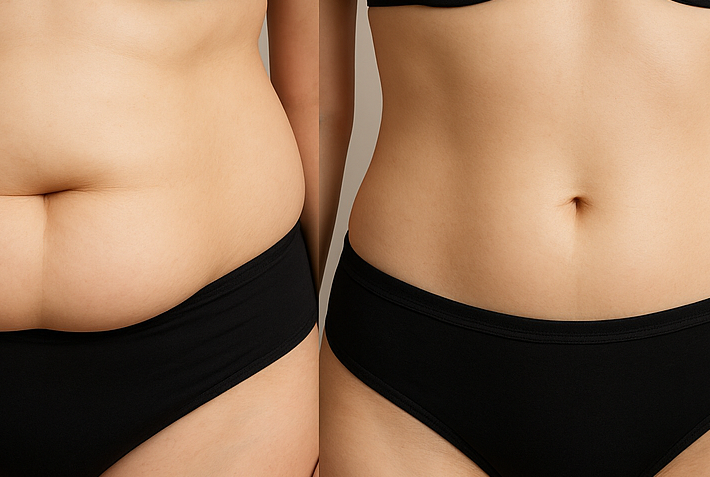.png)
Abdominoplasty
Abdominoplasty
Cosmetic surgery of the abdomen can be referred to as: abdominoplasty, abdominal dermolipectomy, tummy tuck, or abdominal plasty. It concerns both men and women and affects all abdominal structures: fat, skin, and muscles.
Who is abdominoplasty for?
It addresses excess skin of the abdominal wall, reduces fat deposits in the abdomen and hips, and tightens the muscles.
Two main situations lead to a tummy tuck:
- Abdomens damaged by multiple or twin pregnancies
- Significant weight fluctuations (yo-yo), for example after sleeve, bypass, or gastric band surgery
This results in an unsightly abdominal sagging: diffuse excess with wrinkled skin or an abdominal apron covering the pubis. Coverage by social security is possible after prior agreement.
Abdominoplasty is also aimed at men. It is often associated with extensive liposuction of the abdomen and hips.
What scars and types of tummy tuck are there?
Abdominoplasty involves tightening the skin by removing the damaged excess from the bottom. The scar is located at the level of the pubis, hidden in the underwear, and may extend towards the hips. Depending on the case, the navel may be repositioned, lowered, or left intact.
Complete abdominoplasty
- Long scar + scar around the navel
Mini-abdominoplasty
- Short scar (similar to an extended cesarean), without a scar around the navel
Repair of abdominal muscles
Pregnancy or aging can cause a separation of the rectus abdominis muscles (diastasis). During the procedure, skin tightening allows for exposure and tightening of the muscles along their entire height, creating a true internal girdle. This repair can also be performed during a mini-lift.
Does abdominoplasty eliminate a large round belly?
The causes of a large round belly can be:
- Excess skin and fat (in men, intra-abdominal fat)
- Muscle laxity with or without diastasis
- Chronic bloating (often related to food intolerances)
- Exaggerated curvature of the spine
Surgery alone does not address all causes: dietary management and regular physical activity are necessary in parallel.
Anesthesia and hospitalization
Anesthesia is most often general, sometimes epidural. Hospitalization lasts 1 to 2 days depending on the extent of the procedure. Anti-thrombosis compression stockings are worn during and after the operation.
Duration of the procedure
An abdominal dermolipectomy lasts between 1.5 to 3 hours depending on the size of the area to be treated and the number of structures involved.
Post-operative care
Dressings are necessary for 2 weeks, often done by a home nurse. A compression belt is worn 24/7 for about 3 weeks. In the case of muscle repair, strenuous activities are prohibited for 2 months, with reinforced girdle at the beginning.
Wearing compression stockings and anticoagulant treatment (heparin for 10 days) is mandatory. The scar evolves: pink for 3 months, then whitens over 6 to 12 months. No sun exposure before 3 months.
The work stoppage is 2 to 3 weeks. Resuming sports is possible after 1.5 months. The final silhouette is achieved around 3 months.
In conclusion
Abdominoplasty is a comprehensive surgery of the abdomen (skin, muscles, fat). Despite the scars, it offers a significant improvement in silhouette, comfort, and clothing fit, with a high satisfaction rate.
Its preparation is essential and requires a rest period of at least 2 weeks. It is a major but rewarding procedure.
